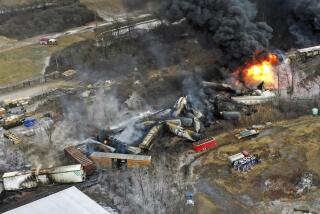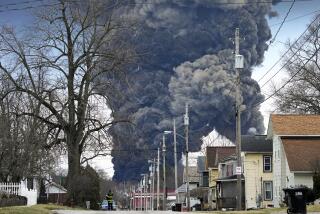Runaway Train, No Plan?
Faced with 31 runaway freight cars barreling toward downtown Los Angeles on Friday, Union Pacific officials gambled that diverting the cars to a side track at Commerce would produce the lesser of catastrophes. The 3,883-ton train derailed, raining steel and its load of lumber across a residential neighborhood and demolishing four homes. Miraculously, no one was killed or seriously injured.
It will be up to the National Transportation Safety Board to determine whether railroad officials could have found a better place to stop the train once it escaped a Montclair switching yard. Union Pacific officials said Monday that until a few minutes before the derailment they thought the runaway cars were going more slowly than they were and might stop safely after being switched to a different track. However, one engineer says the cars’ speed surely would have been electronically monitored.
This much is obvious: Inaction by Union Pacific before and after the wreck compounded whatever colossal error set the cars loose in the first place. Astoundingly, in the 20 minutes between the time railroad dispatchers learned of the runaway and when the train derailed, no one notified a single L.A. County emergency agency.
Union Pacific defends its dispatchers as having been too busy finding a way to stop the train. As harrowing as that must have been, one phone call was all it would have taken to have firefighters, sheriff’s deputies and paramedics standing by. The low human toll is due to luck and to the courage of residents who dashed into collapsing houses to assist neighbors and helped children out of yards littered with live wires.
Once the train crashed, Commerce City Council members -- who learned of the disaster from television news -- helped shocked residents find shelter that first night, even using their own credit cards to pay for toothbrushes and underwear at Target. Union Pacific is now picking up these tabs, but its absence in those first hours was glaring, especially compared with the speed with which the railroad union brought in mental health counselors for five crew members now under investigation. If the five are shaken by what happened, imagine how those who lost homes and a sense of safety must feel.
“This is not something you train for,” Union Pacific spokesman John Bromley told The Times, explaining how impossible it is to recreate the pressure railroad officials were under. But it is something you plan for. Any business that regularly sends thousands of tons of iron hurtling through residential neighborhoods has to be prepared for disaster. The railroad can’t predict what can go wrong at every turn and spur of the track, but it must plan -- and train -- for when something does.
More to Read
Sign up for Essential California
The most important California stories and recommendations in your inbox every morning.
You may occasionally receive promotional content from the Los Angeles Times.










